Very little beats the feeling of standing on top of a mountain, gazing around at a stunning panorama of nature. Unless, of course, you have your faithful canine friend at your side, sharing in the triumph of the climb. Without a doubt, hiking with dogs is a rewarding experience.
But taking your furry companion along for the adventure requires planning and forethought. Use the tips and advice in this comprehensive guide to ensure you and your pooch safely and enjoyably navigate the world of hiking together.
Why Hike With Your Dog?
Hiking with your dog is about more than exercise; it's about sharing a love of the outdoors and creating unforgettable memories.
Of course, it helps that the physical and mental health benefits are substantial too.
The cardio workout helps maintain a healthy heart, and the active movement promotes lean muscle tone in both you and your dog.
For you, the mental benefits include boosted serotonin levels, heightened creativity, and better focus. Tackling trails and reaching summits brings a sense of accomplishment, boosting self-esteem and fostering resilience.
Meanwhile, for your dog, a good hike provides a wealth of sensory stimulation that can ward off boredom and associated problematic behaviors. The diverse sights, smells, and sounds on a good hike can greatly enhance the mental well-being of your pet.
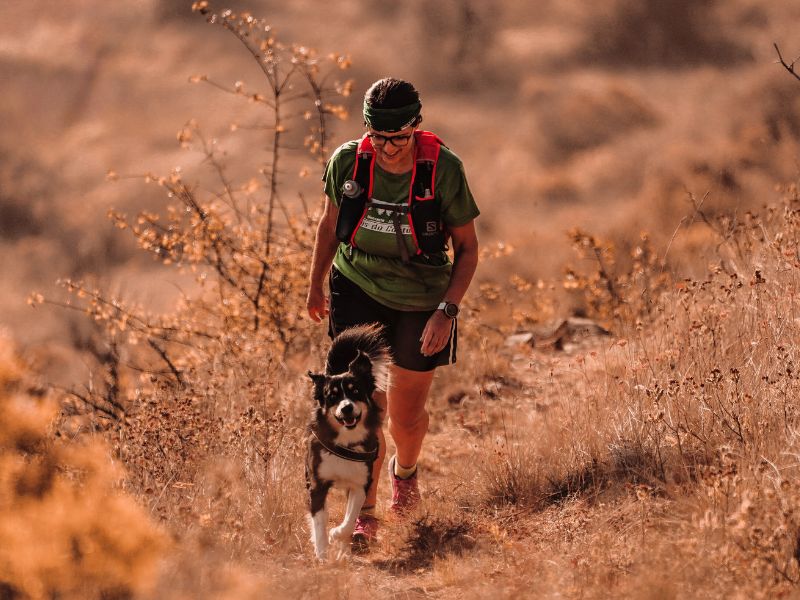
The truth is, I could carry on talking for days about the reasons to go hiking with your dog. But perhaps the most significant benefit of all is the deepened bond that results from sharing the adventure.
Hiking together strengthens the mutual trust and understanding between you and your pet, enhancing your relationship in a profound way.
Choosing The Right Breed For Hiking
While most dogs enjoy a good hike, some breeds are particularly well-suited for the trails. Breeds like Border Collies, Labradors, and Australian Shepherds were bred to work and have the stamina and temperament for longer treks.
However, don't be too quick to rule out small dog breeds for hiking. Some shorter-legged pooches, like the energetic Jack Russell Terrier, easily keep up and can make excellent hiking companions too.
When it comes down to hiking with dogs, always consider your pet’s individual characteristics. Factors like age, overall health, size, and stamina play a significant role.
For example, older dogs or dogs with health issues may not be able to handle long or challenging hikes. Older dogs may have joint problems like arthritis that can make long or strenuous hikes painful or even harmful.
They may also have decreased energy levels and move at a slower pace, making them less capable of handling the physical demands of a challenging trail.
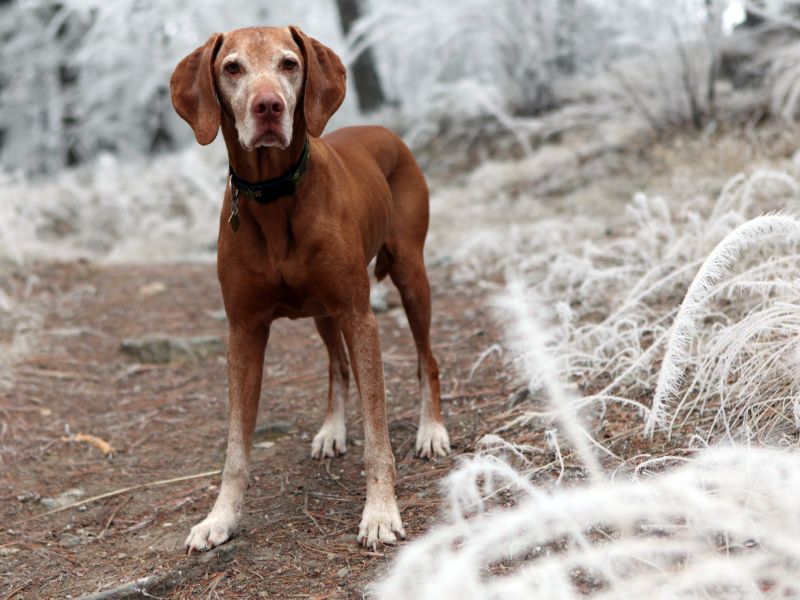
Puppies, although brimming with energy and enthusiasm, are still growing. Their bones and joints are not fully formed. Hiking on rough terrain or embarking on long or strenuous trails before they’re ready can potentially harm their developing skeletal system.
The reality is overexertion at a young age can lead to long-term issues, such as hip dysplasia, especially in larger breeds.
In any case, for any breed or age dog, it’s always wise to consult your vet before making hiking a regular activity.
As recommended reading, check out our posts on Best Dogs For Hiking and Worst Dogs For Hiking. You’ll get the low down on how certain breeds perform on the trails.
Selecting A Suitable Hiking Trail
Whether taking your dog hiking for the first time or trying a new route, it’s crucial to do your homework and pick the right trail. This will ensure a positive hiking experience for you and your favorite companion.
The first time you go hiking with your dog, starting with a short, easy, flat trail is a good rule of thumb. This will allow you to gauge how your pet behaves on the hike and determine what they are capable of.
It will also give you the opportunity to assess the trail difficulty. If things get hairy, turning back or getting help on a shorter trail is easier.
Once you have seen how your furry friend fares on a hike, gradually introduce more challenging routes with different terrains and inclines.
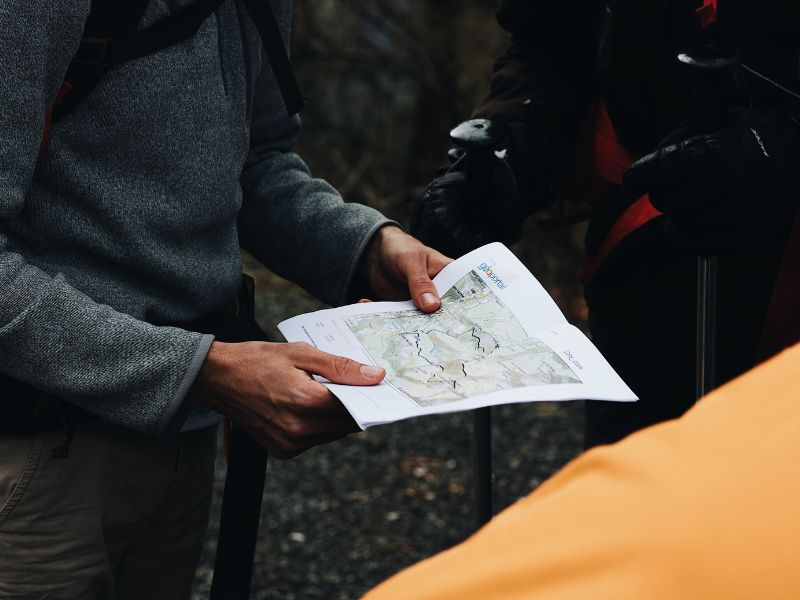
Every time you plan on hiking with dogs, remember to research the trail in advance. Factors such as climate, altitude, terrain, and potential hazards are all important considerations to keep in mind and help you prepare.
It’s also an idea to double-check that dogs are permitted and whether or not they must be leashed. Always respect the rules set for the trail or park you’re visiting. These rules are designed to protect wildlife, the environment, and your pet.
Want some inspiration on where to go hiking across the world with your furry friend? Read up on The Best Hikes With Dogs here.
Preparing Your Dog For A Hike
Ensuring an enjoyable and safe dog hiking experience hinges on thorough preparation. Your journey begins well before setting foot on the trail.
At the heart of this preparation is basic obedience training. When hiking, your dog should be responsive to crucial commands such as "sit," "stay," and "come." This responsiveness is essential for their safety and that of others you might encounter, including hikers, canines, and wildlife.
Our post on How To Train Your Dog To Hike With You has tips that should help in this regard.
Mastering recall—your dog's immediate response to being called back—is paramount if you plan to let your pet hike off-leash. While hiking with your dog off-leash can give a delightful sense of freedom, it should never be at the expense of safety or obedience.

Fitness is another key consideration. Just like humans, dogs need to build their endurance progressively. Embarking on long, challenging hikes without prior conditioning can negatively impact your pet's health and lead to injuries.
Start with short, easy walks in your local area, then incrementally increase the distance and difficulty over several weeks or even months. Monitor your pet's reaction to the increased activity to ensure they handle it well.
Health checks are another vital aspect of preparation. It's essential to consult your vet before undertaking hikes with your dog.
The vet can provide a general health check and ensure your pet's vaccinations are up-to-date.
They might also advise on preventive treatments for parasites such as fleas and ticks, which you'll likely encounter on the trail. This preventive care will help ensure your pet is in the best possible shape for hiking.
Also read: Dog Tick Repellent For Hiking
Essential Gear For Hiking With Dogs
Having the right hiking gear enhances your abilities and experience on the trails - whether it's sturdy boots, a reliable backpack, or even your favourite designer hiking clothes. And the same goes for your pooch. Each piece of equipment they use can play a vital role in their safety, comfort, and enjoyment while hiking.
Leash and Harness
Start with the basics: a sturdy dog hiking leash and dog hiking harness.
The leash ensures you can maintain a certain distance radius between you and your furry friend at all times, while a well-fitted harness gives you more guiding control over your dog. A harness also reduces tension around the dog’s neck if they typically pull on the leash.
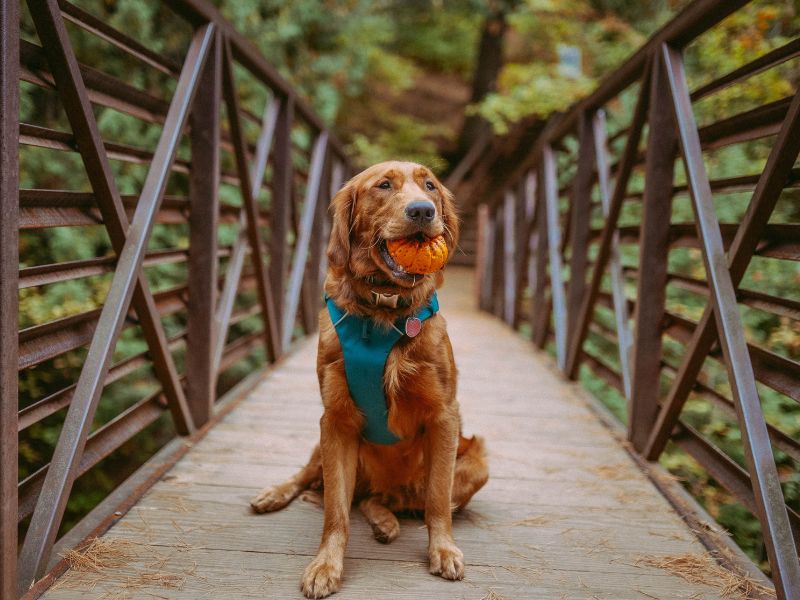
Besides a harness, you might also need a suitable hiking dog collar for attaching the leash.
All these items are fundamental to maintaining control of your dog on the trail. There will be times when you want to keep them close, for example, if you encounter wildlife or need to cross steep terrain. Perhaps there’s a known patch of poisonous plants ahead or a boisterous bunch of dogs passing by.
Hiking Boots
Depending on the natural environment, you might need to consider additional protective gear for your dog.
Dog hiking boots, for instance, can protect your pet's paws from sharp rocks, thorns, hot pavements, or icy conditions. These boots can be particularly beneficial on rough terrains or in extreme weather conditions.
First Aid Kit
Emergencies can happen when you least expect them, so it's essential to be prepared when hiking with dogs. A specific dog hiking first aid kit is a must-have in your trail gear.
This kit should include bandages, antiseptic wipes, tweezers, and a tick remover tool. It's always better to have these items and not need them than to need them and not have them.
Sustenance For The Trail
Hydration and nutrition are paramount when undertaking strenuous activity. Always pack enough food and water for both you and your pet.
Remember, your dog will burn a lot of energy and lose water through panting, so frequent water breaks are essential.
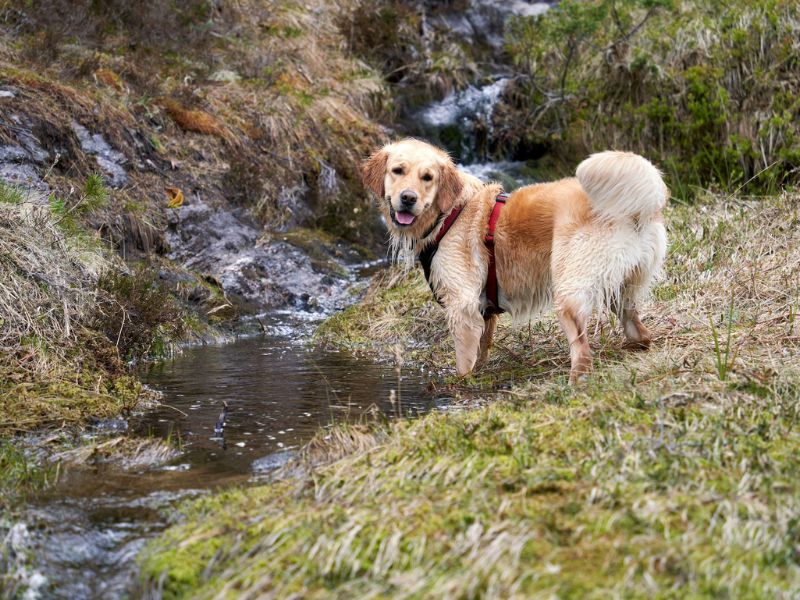
Backpack Or Carrier
A dog hiking backpack can be a helpful accessory if your dog is large enough and in good health. These packs allow your pooch to carry their own supplies, reducing your load.
When buckling up, ensure the weight in the backpack is distributed evenly. Vets say the total load shouldn’t exceed 20% of your dog's weight to prevent strain or injury. Also consider your canine’s general health and age before loading on a backpack.
For smaller breeds, older pooches, or longer hikes, consider bringing a dog carrier for hiking as a backup. It can offer your pet a safe and comfortable resting spot should they tire.
Check out our complete Dog Hiking Gear List here.
Hiking Etiquette and Safety Rules
Hiking trails are shared spaces that diverse groups of outdoor enthusiasts utilize. Ensuring that everyone respects and enjoys these spaces requires a commitment to responsible and considerate practices.
When you bring your dog along on a hike, don’t only consider your own experience. Consider the impact of your pet's presence on the environment and on others.
One fundamental aspect of trail etiquette for hiking with dogs is adhering to leash laws. These rules are in place not just for the safety and comfort of other hikers but also for the well-being of your dog.
Keeping your dog on a leash prevents them from straying off the trail, potentially getting lost, or encountering hazards.
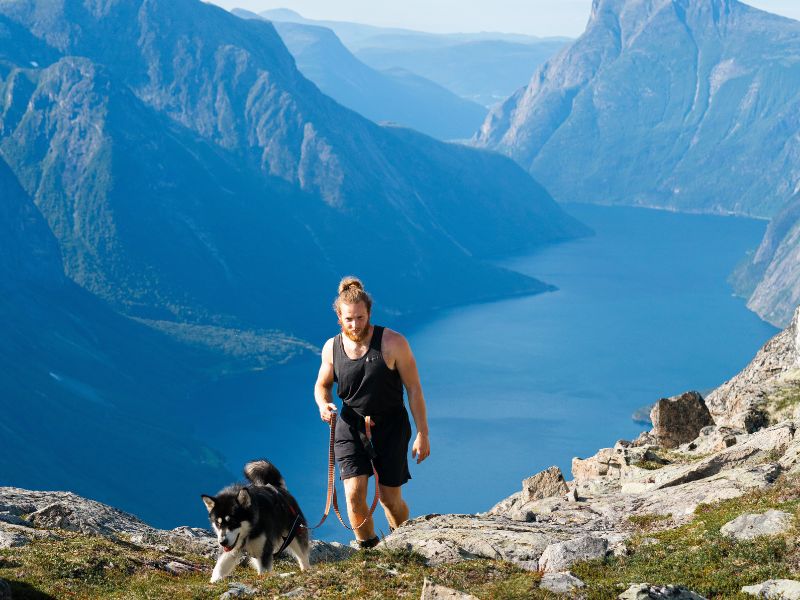
Interactions with wildlife pose another serious consideration. Even if your dog is well-behaved and gentle, their presence can be stressful or harmful to wild animals. Furthermore, some animals may pose a threat to your pet.
Maintaining control over your dog by putting them on the leash or calling them to your side helps ensure their safety and the well-being of wildlife.
Similarly, it's crucial to clean up after your dog. Not only is leaving pet waste behind unpleasant and disrespectful, but it can also damage local ecosystems. Always pack waste bags or a dog poop container for hiking and carry out what your pooch leaves behind.
The principles of "Leave No Trace" - the practice of minimizing your impact on the environment - apply to you as a dog owner and hiker. This philosophy extends beyond picking up after your pet. It also involves respecting trail signs, refraining from venturing off designated paths, and not disturbing local flora and fauna.
Respecting these guidelines ensures that the trails remain pleasant, safe, and accessible for everyone—humans and dogs alike.
Tips For Making The Hike Enjoyable For Your Pooch
Taking your dog on a hike should be as much an enjoyable experience for them as it is for you. Dogs, much like their human companions, have a natural curiosity and appreciation for the great outdoors.
To make the most of this, it's essential to strike a balance between exercise and exploration.
Take A Break
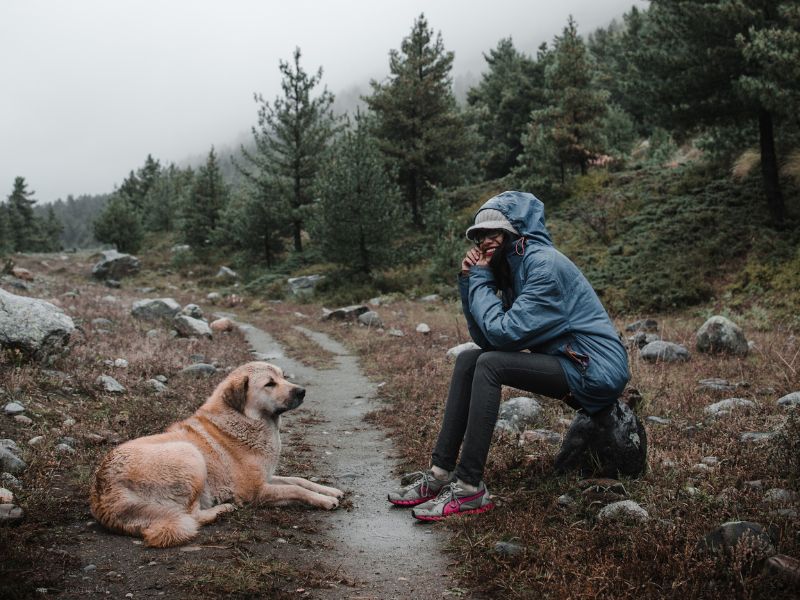
Be sure to take regular breaks during your hike. These rest stops offer a fantastic opportunity for your dog to engage with their environment, sniff around, and satisfy their curiosity.
Remember, for a dog, hiking isn't just a physical activity—it's also a sensory adventure. Breaks give them a chance to process all the new sights, smells, and sounds.
Hydrate On The Regular
Hydration is a key concern when hiking with dogs. Unlike humans, dogs don't sweat to cool down. They pant instead.
This, coupled with the exertion of hiking, can quickly lead to dehydration.
Regularly offer your dog water during rest stops to prevent overheating and dehydration. You’ll find that having a collapsible dog bowl for hiking is handy as it doesn’t take up much space when packed.
There’s A Good Dog
Positive reinforcement plays a crucial role in keeping your dog engaged and motivated during the hike. Treats and praises not only incentivize good behavior but also make the experience more enjoyable for your pet.
Watch Body Language
Lastly, it's essential to keep a close eye on your dog's body language. Dogs can be incredibly stoic, and sometimes it's easy to overlook signs of exhaustion or discomfort.
Watch for heavy panting, slowing pace, limping, or reluctance to move. If your dog shows any of these signs, it's time to take a break or even consider turning back.
Always remember that your dog's well-being comes first—the goal is for the hike to be a positive, enjoyable experience for both of you.
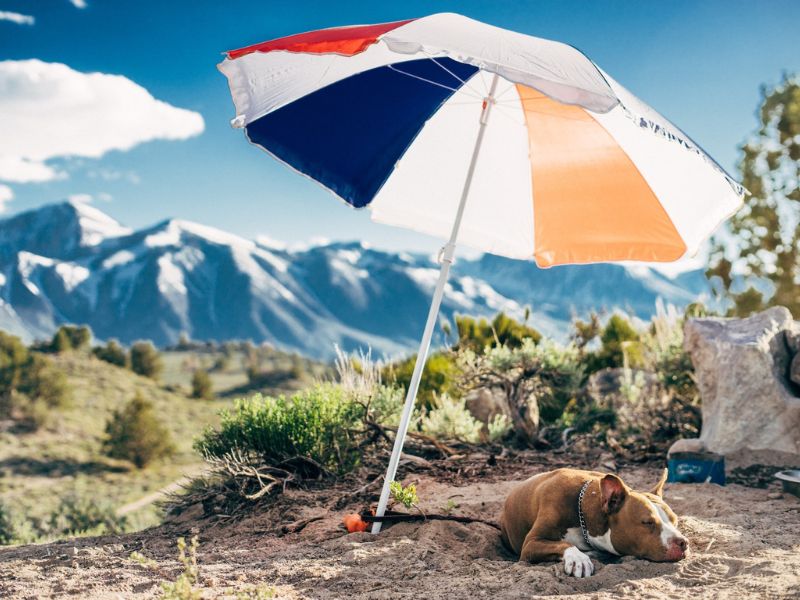
It's Time To Go Adventuring
Hiking with your pooch is about the journey, not the destination. It's about exploring nature together, overcoming challenges, and creating memories.
With a bit of preparation, the correct gear, and the right attitude, you’ll soon find that hiking with dogs opens up a whole new world of adventure.
We'd love to hear about your hiking experiences and any tips you've picked up along the way. Leave a comment below and share your adventures with us!

